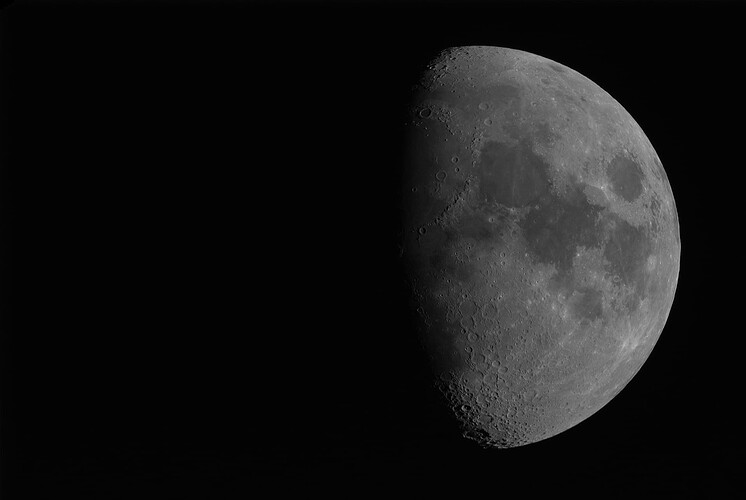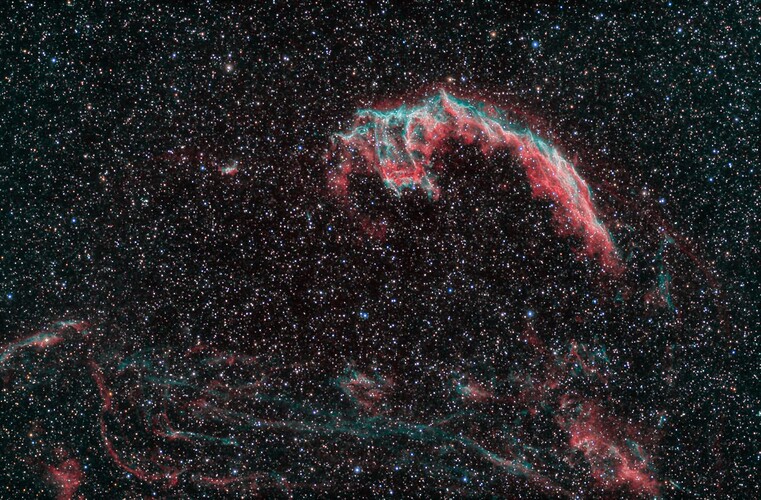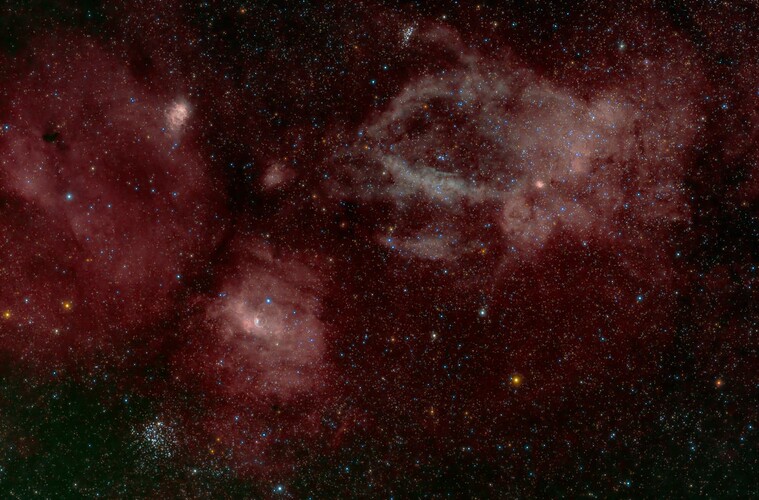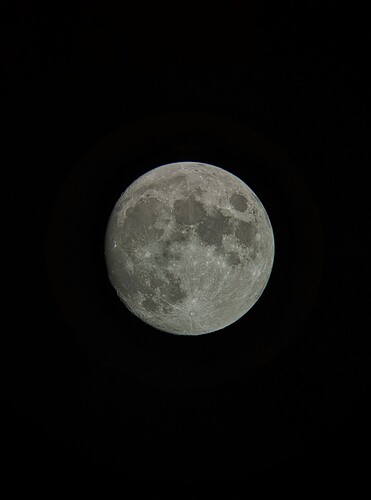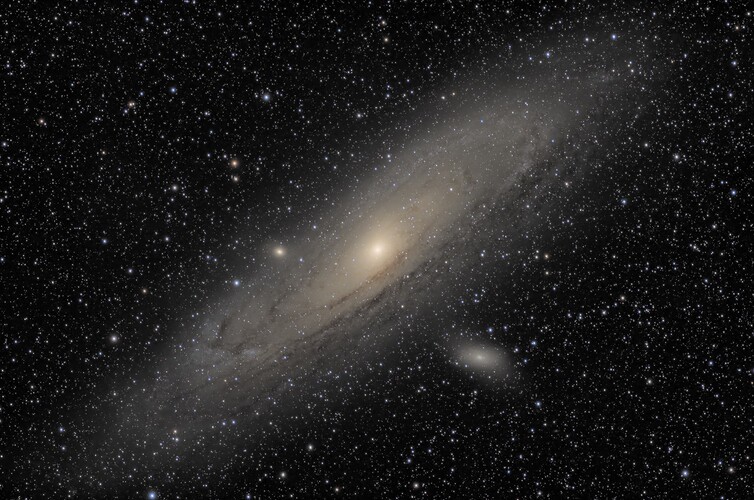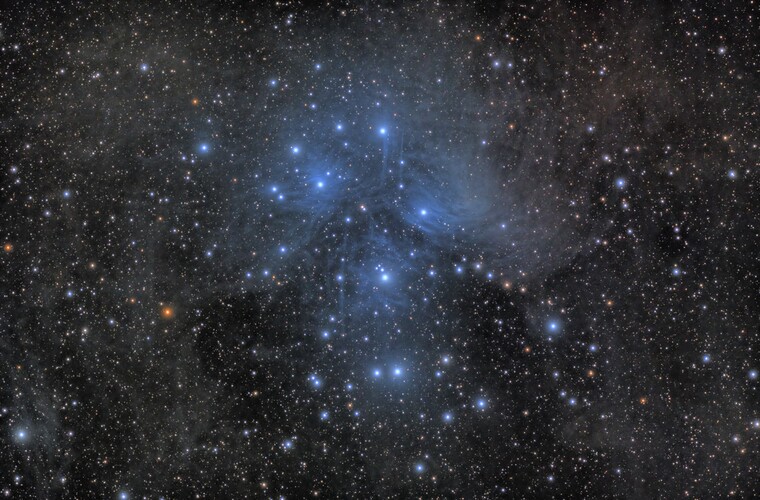That’s really nice! I haven’t had the guts to even try a shot like that yet.
Beautiful.
We’re at 65% Waxing Gibbous right now which is just about my favorite part of the lunar cycle to photograph because you get a big portion of the Moon while still getting lots of shadow to bring out the detail of the craters. I actually took this at about 7 PM this afternoon when it was still daylight and it turned out pretty well!
Nice! I keep saying that I will set my 6" RC up for lunar/planetary imaging, but I “never seem to find the time” (to coin a phrase).
I spent most of the summer/fall shooting “emission” nebulas with a new duo-band filter (Antlia AlpT). It has two narrow (5nm) passbands, one for hydrogen (deep red) and the other for oxygen (blue/green). Then I also take a couple of hours worth without the filter and layer in just the stars’ natural colors. With the filter alone the stars are mostly all an odd shade of blue.
Here is the East Veil Nebula. It is part of an expanding cloud left behind from a supernova that occurred about 20,000 years ago about 2400 light years away.
The second shot is an area in the constellation Casseipeia. The gas cloud in the upper-right has the nickname “Lobster Claw Nebula”. Embedded in the gas cloud in the lower left is the Bubble Nebula. The Bubble is physically embedded in that gas cloud and is the result of intense radiation pushing gas out away from a massive, very hot young star. There are two open clusters of stars in the frame, M52 in the lower-left and NGC 7510 top-center,
Pretty pics!
I was all into astronomy and was going to do some astrophotography but lived in a pretty bad red zone. Then 5 years ago moved to a lot darker sky area and have not had a scope while living where I am now for some dumb reason. So, just bought a basic 10" dob so I’d have something to look through. Thinking about getting a new astro setup though and these pics get me more in the mood for sure.
A 10" dob and decent skies is an awesome combination!
Hell even a 4” and a red zone can do a lot.
Yes, I used to have all sorts of scopes and my 3-4" refractors were nice with wide field views. My wife hated it as one time we drove up to Vancouver to pick up a CPC 1100 and it was Winter and her car had all sorts of issues but we made it back home and she told me that was the last telescope I was going to buy. I bought many up to then…bought and sold. Used it for a few months and bought a 14" dob that was incredible but got in debt and had to sell everything. So, now, happy with a nice 10" and told her no more. Well, after the astro stuff!
Great shots! What software do you use, if you don’t mind me asking? I used Planetary Imaging PreProcessor, AutoStakkert, and GIMP for my most recent shot. I’ve also dabbled with Sequator, DeepSkyStacker, and Planetary System Stacker with limited success.
Thanks!
The mount and camera are controlled by a mini-pc running linux, using an open-source package called KStars/Ekos. I do the pre-processing (flat-field correction) and stacking on my desktop pc in another open-source program, Siril. From there I use StarTools for stretching.
I’m bringing a cell-phone shot into an art gallery which looks foolish (great pics @gruntled), but was happy with the level of detail in this snap. The moon is small, even viewed from Earth.
@Penny_Dreadful how did you take yours? Looks good.
That’s a great shot! I’ve been blown away by just much smartphone cameras have improved over the last couple years. I know the S22 Ultra has a 220mm f/4.9 lens which is just ridiculous for something that small.
As far as my shot upthread goes, I used a D3400 and a cheapo Rokinon 650-1300mm lens.
Exposure - 1/200
ISO - 800
Aperture - f/16
Focal length - 1300 mm
I took 5 shots, processed them using PIPP, and then stacked the frames using AutoStakkert to improve the SNR. Then I adjusted the curves in GIMP to improve contrast a bit, and applied wavelet sharpening to improve the sharpness.
I don’t foresee improving on that much without an actual telescope.
I did want a nice shot of the eclipse this morning, so I set all my stuff up last night, got up early today, and was greeted by a sky that was 90% clouds. So that’s a shame. I don’t think this lens would have been able to do anything with a lunar eclipse anyway. Its aperture is just way too small for something that dim. I got a decent shot a few years ago with my 70-300 mm lens when I had crystal clear viewing (on a very, very cold January night).
Nice pic even if from a prior lunar eclipse. My cell phone photo was actually through a telescope, but through an eyepiece and not a dedicated setup.
I got up this morning and the eclipse was great from here (near Toronto). It was right at sunrise and a neat perspective as the sun was just rising behind me and the moon setting in front, both on the horizon. So effectively my shadow was on the moon. I used my 10x50 binoculars for the view, and to share with my daughters who I had dragged out.
Not so much astrophotography, more astro just looking at it, could I ask for advice on what I should look for in weather forecasts that would indicate the best conditions for viewing? I have a strong hankering to go down home, up on bald hill, and dig on the milky way a bit.
obvious cloud cover, but also humidity. Cooler (but above freezing) clear nights tend to be best
What the hell is the dew point, and should I care? I’d like to spot a day a few days out where I could plan to visit back in the country and spend a night on my back gazing, other than clear, is there an advanced course in this?
You can get cloud cover forecasts in various places. I usually use https://www.astrospheric.com
Dew point is the temp at which dew would start to form. Most people pay attention to the dew point in the summer, as a way to gauge how miserably sticky it feels outside.
A couple of recent images of standard showpiece objects.
M31 (Andromeda Galaxy). ~6 hours under reasonably dark skies an hour drive from where I live:
(I dare you to go back to my first post in this thread in Fall 2020 to compare to my first shot of M31)
The Pleiades star cluster M45. At only about 440 ly from here they are one of the nearest star clusters. All the cluster members are roughly the same age (~100 million years old) and still in the very hot, blue stage of stellar evolution. They are traveling together through a large cloud of interstellar dust. The cloud is unrelated to the cloud from which these stars would have originally formed - they’re just passing through. I shot this from home, so lots of light pollution. I wanted to get an idea how much exposure time it will take to be able to stretch out the surrounding dust clouds that are not reflecting the bright blue light from the cluster. This is 17 hours, and the outer dust regions are still quite noisy. At least another 17 hours needed, I would think.
If you zoom in a bit above brightest star at the top there’s a long smudge - which is actually an edge-on spiral galaxy located > 300,000,000 light years away:
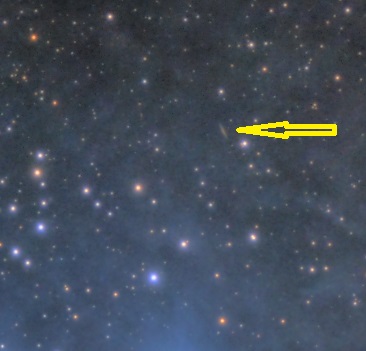
Beautiful.
Those are great. I have a book of the best astronomical photos that were available in the 70s, many from major observatories. It astonishes me how amateurs with electronic sensors and image processing can so far surpass the best that could be done in the film era (not to minimize your accomplishment here; the dynamic range you capture in the Pleiades pic in particular is outstanding)
